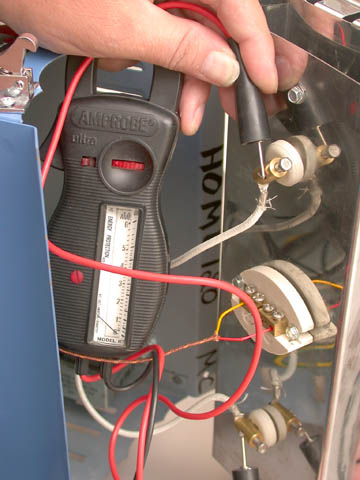 |
|
|
Kiln Pointers
|
|
|
How to Use an Ohmmeter |
An ohmmeter is an inexpensive aid in determining if an element is broken. I saw an ohmmeter just a few weeks ago at a hardware store for only $12.00. The ohmmeter measures the electrical resistance of a wire in ohms. The higher the ohms, the greater the resistance. As an element ages, the resistance increases, and the ohms reading becomes higher. There are two types of ohmmeters: the type with a needle indicator (analog), and digital. (The photo above shows an analog meter.) Ohmmeters have two probes. When you touch the probes together, the analog ohmmeter needle should move all the way over. A digital meter should read zero ohms. If your kiln uses 4-way rotary switches, an ohmmeter can check not only the elements but also the kiln’s entire electrical system. The readings are taken at the cord plug; for that, you will need instructions from the kiln manufacturer, since it varies depending upon the kiln model. If your kiln is electronic or uses infinite control switches, remove the switch box and check the elements at the element connectors. 1) The kiln should be cold when you test the elements. Unplug the kiln or shut off the circuit breaker. 2) The element connectors are covered by a switch box, which is usually on the front of the kiln. Remove the switch box. You will see two connectors for each element. There is no need to remove the lead wires from the connectors provided you have only one wire attached to each element connector. If you have more than one lead wire on a connector, it may mean that your elements are wired in series/parallel. In that case, temporarily remove the wires from one of the connectors. Otherwise you could get a wrong reading. (Current from the ohmmeter battery can pass through other elements than the one you are testing.) 3) Place the ohmmeter probes against the two element connectors of the element you are testing. You may need to clean a spot on the connectors to get a good electrical contact. For best results, touch the probes to the element connectors and not to the twisted element ends. If an element is burned out, it will show as infinity ohms on a digital meter or no needle movement on an analog meter. A worn out element is roughly 10 percent higher in ohms than a new element. (See your kiln’s wiring diagram for the ohms of new elements for your kiln.) However, if your ohm readings are high, that does not always mean the elements are worn out. Your meter may be inaccurate. A better indication of element wear is the length of firing time. As the elements age, the firing time will become longer and longer. MY TRIP TO WASHINGTON, DC Last Friday I taught sessions on kiln maintenance at Vitrum Studio in Beltsville, Maryland and Weisser Glass Studio in Kensington, Maryland. I always enjoy being with glass artists, because they exude enthusiasm. If you were there, thanks for attending. I enjoyed viewing glass art in the galleries of Vitrum and Weisser studios. They contain some of the finest glass pieces I have seen. When Paragon first started making glass kilns in 1985, the selection of glass fusing was limited. Now you can find pieces of extraordinary design. I asked Kevin O’Toole of Vitrum Studio for the titles of glass art showcase books for those who don’t have a chance to visit galleries. He brought out several large, heavy volumes. I have added two of them—“International Glass Art” and “A History of Glassforming” to Paragon’s recommended reading list. (Select “Products” and then “Books & Videos” from the drop menu above.) VIETNAM WALL Before I left Washington on Saturday, I had only enough time to visit one landmark, and I chose the Vietnam Memorial. I had always wanted to see it. I was expecting a high wall. Instead, it is almost hidden below ground level. A wide, v-shaped swath has been cut into the earth. Black granite panels are lined along that cutout, with a walkway in front. It is as if the ground had opened up to reveal the names of 58,000 dead etched into the black granite slabs. Volunteers made pencil tracings of names from the granite. One man used a stepladder to reach a name for a young woman. He said, “We’ve had the wall now for 25 years, and it is still powerful.” Then he pointed to a medal that had been placed at the base of the wall and said, “What would make someone leave his Bronze Star here?” RAINBOW ART GLASS OPEN HOUSE After seeing the Wall, I drove to Farmingdale, New Jersey for an open house at Rainbow Art Glass. That Sunday I enjoyed talking to glass people for most of the day. One story stands out: A glass artist told me that her husband bought her a used ceramic studio kiln. Without help from anyone, he lugged that kiln down their basement stairs while she was away and later presented it to her as a surprise. I wish I had gotten his name. He deserves a Husband of the Year Award. With best wishes, Arnold Howard Paragon Industries, L.P. – Better Designed Kilns 2011 South Town East Blvd. Mesquite, TX 75149-1122 Voice: 972-288-7557 & 800-876-4328 / Fax: 972-222-0646 ahoward@paragonweb.com / www.paragonweb.com --------------------- Feel free to email this Kiln Pointer to friends. To read back issues Click here or go to www.paragonweb.com, select “Support,” and then “Kiln Pointers” from the drop menu. To respond to this Kiln Pointer, press Reply. Your email will go directly to Arnold Howard. PRIVACY NOTICE: Under no circumstance do we share or sell your email address. Copyright 2006, by Paragon Industries, L.P. |
|
|

|
|
|
|
|
“Custom and standard Kilns and Industrial Furnaces for ceramics, pottery, heat treating, enameling, |
||||
